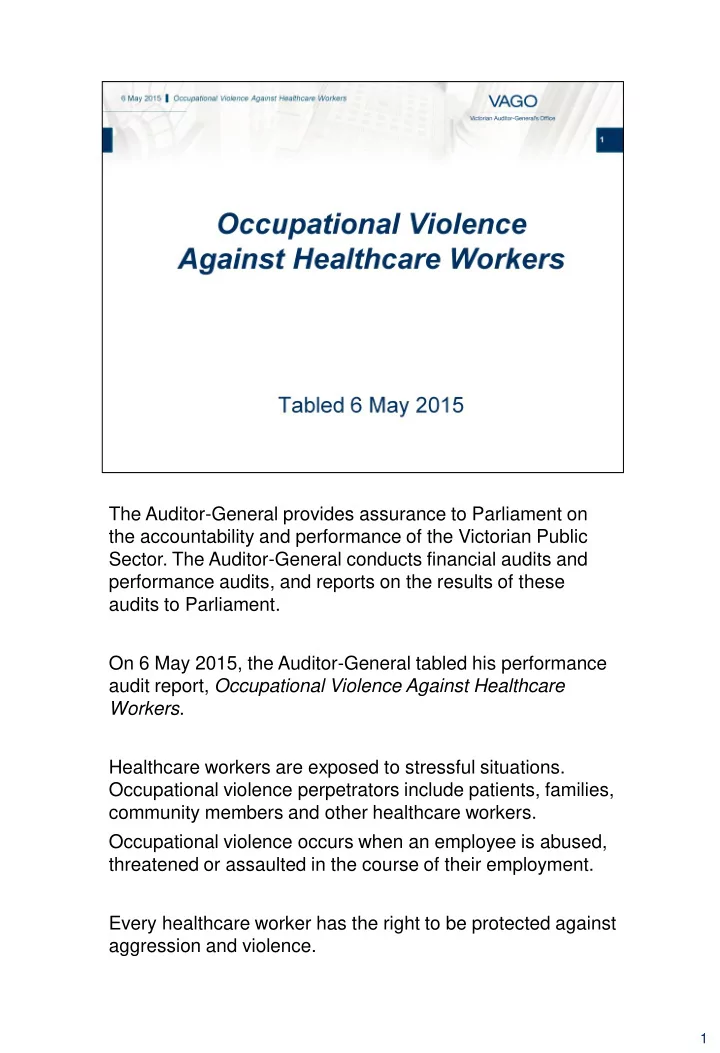

The Auditor-General provides assurance to Parliament on the accountability and performance of the Victorian Public Sector. The Auditor-General conducts financial audits and performance audits, and reports on the results of these audits to Parliament. On 6 May 2015, the Auditor-General tabled his performance audit report, Occupational Violence Against Healthcare Workers . Healthcare workers are exposed to stressful situations. Occupational violence perpetrators include patients, families, community members and other healthcare workers. Occupational violence occurs when an employee is abused, threatened or assaulted in the course of their employment. Every healthcare worker has the right to be protected against aggression and violence. 1
Occupational violence against healthcare workers is a significant issue with serious social, health and economic consequences. Our audit examined how effectively systems are protecting healthcare workers. We found shortcomings in all the audited agencies despite efforts to address the issue. Initiatives aren’t always understood or applied by staff, or evaluated. We found the data collected to be of poor quality. Stronger leadership is needed to reinforce key messages about preventing and managing occupational violence. 2
We assessed whether the Department of Health & Human Services (the department), WorkSafe, Ambulance Victoria and health services adequately protect and support healthcare workers from occupational violence. 3
We found extensive under-reporting of violence incidents, mainly because of: • cumbersome reporting systems in hospitals • staff reluctance to report violence or aggression by ill patients, as this is often seen as just ‘part of the job’, and • perceived management inaction. Health services’ incident data is not reliable or comparable. It does not accurately reflect the severity of incidents. Imagine a pregnant healthcare worker being kicked in the stomach or a worker being half strangled. These incidents have the potential to cause significant harm, but were recorded as ‘near miss’ or ‘no harm’, the lowest categories of incident severity rating. Sector-wide data collected by the department is limited to 4
nurses and doesn’t include other healthcare workers. It is not analysed or used to support the sector. Health services need to investigate and address the barriers to reporting. All agencies need to provide greater guidance and oversight to ensure compliance with reporting requirements. 4
We found evidence of reforms at each audited health service and Ambulance Victoria, including: • appropriate policies and procedures • Code Grey response teams • reporting and investigation procedures • governance mechanisms, and • specialist roles. Ambulance Victoria has moved from a manual to an electronic reporting system that can be used in the field. Seventy-four per cent of surveyed hospitals reported using a Code Grey response. Code Grey is a trigger for urgent action involving a team, generally led by a clinician but sometimes by security. We found examples of physical environments designed to 5
reduce the likelihood of occupational violence, like quiet examination areas for high-risk patients or CCTV and duress alarms. 5
Despite this good work, we found several concerning issues: • Policies and procedures are not always known, consistently applied or evaluated for effectiveness. • Physical design considerations are not part of regular environmental audits. With the exception of mental health services, training is not mandatory, is poorly attended, is too short, and is insufficient. It is also not evaluated in relation to skill development. A key barrier is the cost associated with backfilling positions so staff can attend. Health services and Ambulance Victoria need to make sure that: • controls are fully implemented and consistently monitored and evaluated, and • that workers are appropriately trained. This means providing flexible and targeted training. 6
The department and WorkSafe have provided guidance but this is not systematic, comprehensive, regularly reviewed or evaluated. WorkSafe rarely uses its inspection or enforcement mechanisms, instead focusing on a limited number of education initiatives. The department and WorkSafe need to be providing much stronger leadership to support health services and Ambulance Victoria. 7
We made 10 recommendations focused on: • building robust evidence around what works at the local and sector level • making sure all healthcare workers are appropriately trained • raising the community’s understanding of the impact of occupational violence, and • making more active use of enforcement tools by WorkSafe. 8
The department, WorkSafe and Ambulance Victoria accepted all recommendations. They outlined when and how they intend to address each recommendation. Their responses are in the report. The department has coordinated responses from health services and will monitor their actions. The Auditor-General will also monitor this progress over time. 9
In summary the audit found that: • The department, health services and Ambulance Victoria need to identify and address under-reporting and build sound, comparable data. • Health services and Ambulance Victoria need to fully implement and consistently review controls, including tailored, flexible training. • The department and WorkSafe need to provide stronger sector-wide leadership to support health services and Ambulance Victoria. 10
There is an unacceptable level of occupational violence against healthcare workers. Greater leadership and attention is required from the department, WorkSafe and health services to protect workers from occupational violence. 11
This is the second of three audits examining health and safety in the health sector. Occupational Health and Safety Risk in Public Hospitals was tabled in 2013. An audit on bullying will table in late 2015. 12
All our reports are available on our website. If you have any questions about this or other reports, or if you have anything else you would like to discuss with us including ideas for future audit topics, please call us on 03 8601 7 000 or contact us via our website. 13
14
Recommend
More recommend